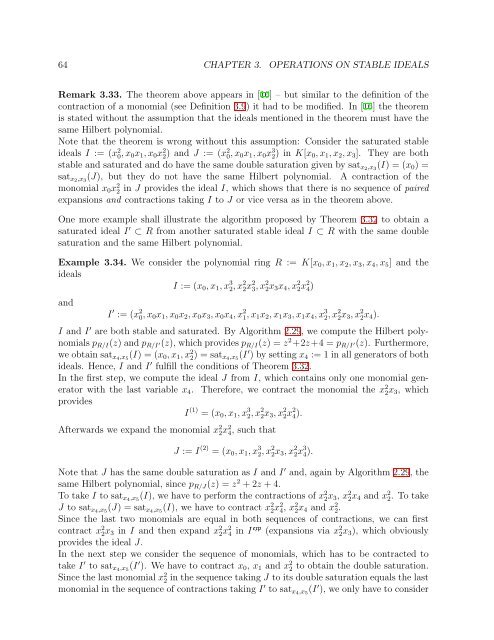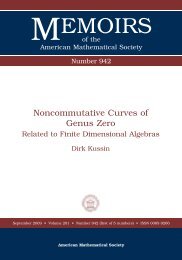University of Paderborn Department of Mathematics Diploma Thesis ...
University of Paderborn Department of Mathematics Diploma Thesis ...
University of Paderborn Department of Mathematics Diploma Thesis ...
Create successful ePaper yourself
Turn your PDF publications into a flip-book with our unique Google optimized e-Paper software.
64 CHAPTER 3. OPERATIONS ON STABLE IDEALSRemark 3.33. The theorem above appears in [16] – but similar to the definition <strong>of</strong> thecontraction <strong>of</strong> a monomial (see Definition 3.9) it had to be modified. In [16] the theoremis stated without the assumption that the ideals mentioned in the theorem must have thesame Hilbert polynomial.Note that the theorem is wrong without this assumption: Consider the saturated stableideals I := (x 2 0, x 0 x 1 , x 0 x 2 2) and J := (x 2 0, x 0 x 1 , x 0 x 3 2) in K[x 0 , x 1 , x 2 , x 3 ]. They are bothstable and saturated and do have the same double saturation given by sat x2 ,x 3(I) = (x 0 ) =sat x2 ,x 3(J), but they do not have the same Hilbert polynomial. A contraction <strong>of</strong> themonomial x 0 x 2 2 in J provides the ideal I, which shows that there is no sequence <strong>of</strong> pairedexpansions and contractions taking I to J or vice versa as in the theorem above.One more example shall illustrate the algorithm proposed by Theorem 3.32 to obtain asaturated ideal I ′ ⊂ R from another saturated stable ideal I ⊂ R with the same doublesaturation and the same Hilbert polynomial.Example 3.34. We consider the polynomial ring R := K[x 0 , x 1 , x 2 , x 3 , x 4 , x 5 ] and theidealsI := (x 0 , x 1 , x 3 2, x 2 2x 2 3, x 2 2x 3 x 4 , x 2 2x 2 4)andI ′ := (x 2 0, x 0 x 1 , x 0 x 2 , x 0 x 3 , x 0 x 4 , x 2 1, x 1 x 2 , x 1 x 3 , x 1 x 4 , x 3 2, x 2 2x 3 , x 2 2x 4 ).I and I ′ are both stable and saturated. By Algorithm 2.29, we compute the Hilbert polynomialsp R/I (z) and p R/I ′(z), which provides p R/I (z) = z 2 +2z+4 = p R/I ′(z). Furthermore,we obtain sat x4 ,x 5(I) = (x 0 , x 1 , x 2 2) = sat x4 ,x 5(I ′ ) by setting x 4 := 1 in all generators <strong>of</strong> bothideals. Hence, I and I ′ fulfill the conditions <strong>of</strong> Theorem 3.32.In the first step, we compute the ideal J from I, which contains only one monomial generatorwith the last variable x 4 . Therefore, we contract the monomial the x 2 2x 3 , whichprovidesI (1) = (x 0 , x 1 , x 3 2, x 2 2x 3 , x 2 2x 2 4).Afterwards we expand the monomial x 2 2x 2 4, such thatJ := I (2) = (x 0 , x 1 , x 3 2, x 2 2x 3 , x 2 2x 3 4).Note that J has the same double saturation as I and I ′ and, again by Algorithm 2.29, thesame Hilbert polynomial, since p R/J (z) = z 2 + 2z + 4.To take I to sat x4 ,x 5(I), we have to perform the contractions <strong>of</strong> x 2 2x 3 , x 2 2x 4 and x 2 2. To takeJ to sat x4 ,x 5(J) = sat x4 ,x 5(I), we have to contract x 2 2x 2 4, x 2 2x 4 and x 2 2.Since the last two monomials are equal in both sequences <strong>of</strong> contractions, we can firstcontract x 2 2x 3 in I and then expand x 2 2x 2 4 in I exp (expansions via x 2 2x 3 ), which obviouslyprovides the ideal J.In the next step we consider the sequence <strong>of</strong> monomials, which has to be contracted totake I ′ to sat x4 ,x 5(I ′ ). We have to contract x 0 , x 1 and x 2 2 to obtain the double saturation.Since the last monomial x 2 2 in the sequence taking J to its double saturation equals the lastmonomial in the sequence <strong>of</strong> contractions taking I ′ to sat x4 ,x 5(I ′ ), we only have to consider
















